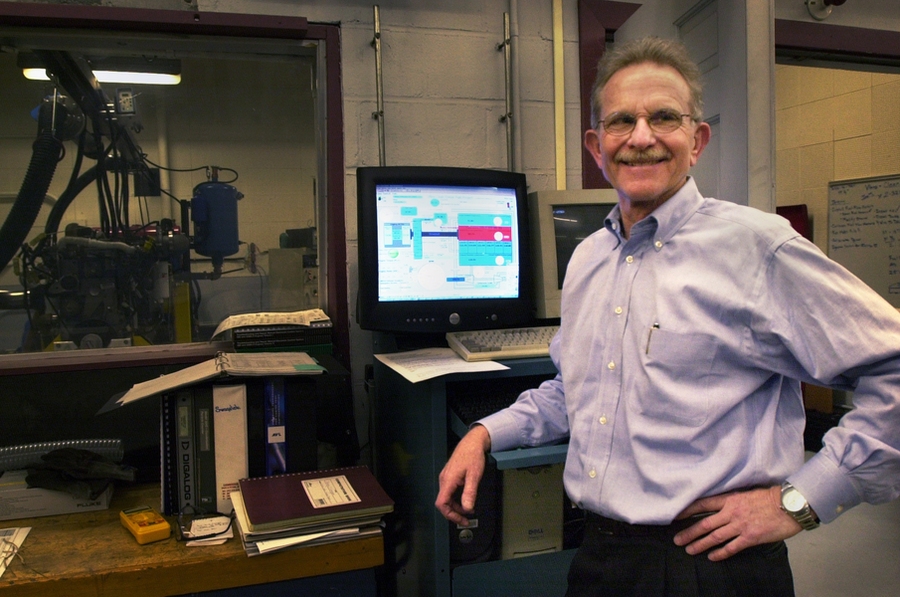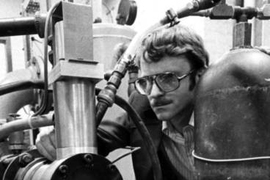The future of the internal combustion engine, with some 2 billion in use in the world today, was a hot topic at last week’s Society of Automotive Engineers (SAE) World Congress in Detroit. There, John Heywood, the Sun Jae Professor Emeritus of Mechanical Engineering at MIT, joined auto industry propulsion system leaders on a panel addressing the theme, “Not Dead Yet — The Ever Evolving Internal Combustion Engine Powertrain.”
Heywood is recognized as one of the world’s preeminent experts on internal combustion engines. In the late 1960s, Heywood joined MIT’s Sloan Automotive Lab, where he started researching why engines created air pollutants and how the amount of those pollutants could be reduced. Heywood thrived in this important emerging area of study.
His research over the past five decades has substantially increased our understanding of how engines work, how they can be designed to reduce their emissions of air pollutants and greenhouse gases, and how to improve their fuel economy. Thirty years after its first publication, Heywood has just completed a second edition of his seminal book, “Internal Combustion Engine Fundamentals.” Its publication comes at a critical time when the automotive industry is faced with difficult questions on how to move forward in an era when alternative propulsion options are getting a lot of attention.
Q: Much of your career has focused on internal combustion engines. What changes have been made in engine design to reduce air pollutant and greenhouse gas emissions?
A: In the past 30 years, there’s been a lot of progress in controlling air pollutant emissions using exhaust after-treatment technology. The key technology component is the catalytic converter in the exhaust system that cleans up the exhaust gases before they go out into the atmosphere. Within these catalytic converters there’s a honeycomb-like matrix with lots of passages with porous surfaces that maximize gas-to-surface contact. Noble metals like platinum, rhodium, and palladium are then spread over this surface area. These metals act as a catalyst that helps get rid of the pollutants at temperatures readily achievable in the exhaust system. As the exhaust gas goes through these channels, unburned fuel is oxidized and oxygen is removed from nitric oxide. It’s a clever combination of engineering and chemistry. This has been very successful in gasoline engines, but not as successful for diesel engines. As a consequence, the environmental problems presented by diesel engines haven’t yet been adequately resolved.
Q: Over the past decade or so, there has been a strong focus on electric vehicles as a solution to transportation’s greenhouse gas emissions problem. Why is work on internal combustion engines still important?
A: Behind this question, there’s this implication: “Why are you bothering with engines when electric vehicles are taking over?” Electric vehicles are certainly going to play a useful role moving forward, but right now it is really difficult to estimate how big a role they will eventually play. I’ve been researching the critical area of electrical vehicle recharging for MIT Energy Initiatives’ “Mobility of the Future” project. If you own a battery electric vehicle, you really need a home recharger. The logistics and cost of having a home charger at most of the homes in America is problematic and expensive.
Various projections for the U.S. suggest that by 2030, some 10 to 25 percent of vehicles might be electrified. The question then remains, what about the other 90 to 75 percent? And what about the large trucks and ships that run on diesel fuel? There are, as yet, no convincing electric options for those vehicles. That is why it is still so important to continue working on internal combustion engines and make them as clean and efficient as we can. The SAE panel members agreed.
Q: The EPA recent issued a report saying that the auto industry is unlikely to meet the greenhouse gas emissions regulations set for model years 2021 to 2025. What is your perspective on this?
A: There are several implications of this recent assessment by the EPA for the automotive industry. Some dozen states have joined California, which was a key partner with the EPA in the setting of these ambitious standards during the Obama administration, and they are unlikely to back down. This could result in having more demanding standards for California and the dozen states that agree with the tougher regulations, with the remaining states following the EPA’s requirements. Having different standards in different states would be a real headache for the auto industry. My hope is that through negotiations, these parties will agree on an appropriate compromise: likely a delay of the original standards for a few years.
In a report I and co-workers wrote as part of an MIT’s Energy Initiative project, we concluded that these 2021 to 2025 emission standards could be met within an additional five years beyond the target dates. Given the challenges in bringing the needed technologies into production vehicles quickly enough, and the shift in consumer’s preferences to larger, heavier, crossover vehicles and SUVs, it’s understandable why a delay might be needed. But this new EPA report has thrown a monkey wrench into this situation.











